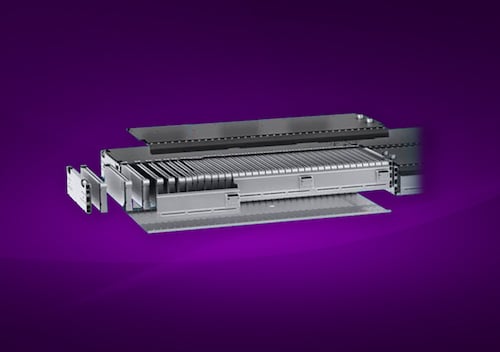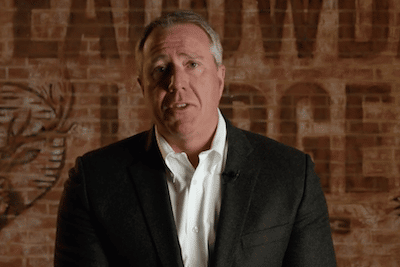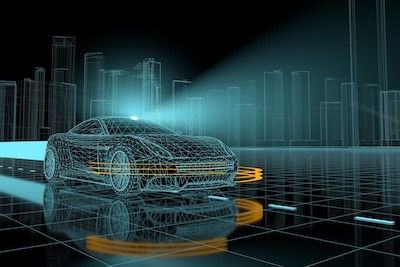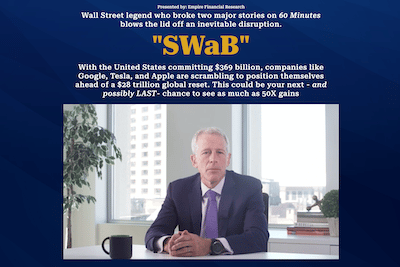Today I’m looking into a Paul Mampilly presentation about a “12 Million Mile Battery” company he’s teasing. According to Mampilly, the company makes a “nanopowder” battery that’s more powerful than any EV battery and could last 12 million miles.
It’s a bold claim, and he’s predicting this technology “could mean unfathomable profits for investors who get in now” and spark a potential “20,300% market surge.”
What company makes this battery? And is Mampilly’s presentation legit?
That’s what I’ll be breaking down in this post. I’ll start by walking you through Mampilly’s “12 Million Mile Battery” prediction. Then, I’ll show you what company I think he’s teasing. And finally, I’ll give you the heads up about Profits Unlimited, the advisory he’s pitching.
Paul Mampilly’s “12 Million Mile Battery” Prediction
The focus of Paul Mampilly’s “12 Million Mile Battery” prediction is a battery that he claims is 25 times more powerful than any electric vehicle battery available.
Given the headline of the presentation, you might assume he was suggesting there’s a battery that can go 12 million miles on a single charge, but that’s not the case. Instead, he says the battery has a range of “over 9,200 miles” and can “last” 12 million miles.
“This innovation could send a Tesla across the country nearly four times — on a single charge!
It is creating the electric vehicle of the future — a gasoline-free car that has the potential to…
✔ Charge in eight minutes — not hours.
✔ Drive a range of over 9,200 miles — meaning you would have months of travel between charging, instead of days.
✔ And last not 1, but 12 MILLION miles.”
What battery is Paul Mampilly talking about?
During the presentation, Paul Mampilly repeatedly shared an image of a battery that I first thought was the so-called “12 million mile battery” his recommended company makes.

However, it seems the above image may represent a generic lithium-ion battery.
I say this because the “12 Million Mile Battery” company Paul Mampilly teases in the presentation, believe it or not, does NOT make batteries.
Instead, the company makes what Mampilly refers to as “nanopowder,” a material that goes into lithium-ion batteries to make them more energy-efficient.
“Similarly … this company does NOT make batteries. It engineers the material inside, the stuff that redefines the battery, making it exponentially more powerful, cheaper and smaller.”
What is “nanopowder?”
Nanopowder is a powdered material that consists of individual nanoparticles (super small particles), and the jar of black powder Paul Mampilly shows in the presentation is nanopowder made from silicon nanoparticles (i.e., silicon nanopowder).
“This is what I’ve been calling nanopowder.
I’m talking about silicon nanoparticles — engineered powder that’s condensed.”
What’s the big deal?
I’m not a scientist, so explaining the significance of this material is beyond my area of expertise. However, according to Paul Mampilly, it can make existing batteries charge 25 times faster while giving them a longer range and battery life.
“You see, almost every battery runs on two things: lithium and graphene.
That’s how it’s been for 40 years, and the battery has been stuck in the same place ever since.
But this engineer has redefined the very chemistry of the battery for the first time, pushing the old lithium ion battery aside…
And created a superbattery by incorporating this technology: this jar of black powder.
In short, it supercharges the battery by 2,500%.
This means 25 times faster charging, longer range and longer battery life.”
Paul Mampilly believes that this nanotechnology is the key to unlocking the “energy storage revolution” because it can massively boost energy density.
But why silicon? Mampilly explains that silicon absorbs 25 times more lithium ions than graphite, the material commonly used in the anode of a lithium-ion battery.
However, even though silicon has the potential to replace the graphite anode, it has the problem of expanding and contracting too much when the battery is charging and being used, which he says can “fracture the battery after a few cycles.”
So, lithium-ion batteries that utilize silicon are more energy-dense, but there’s a problem with how the silicon expands and contracts, which has held back progress.
And that’s where anodes made from silicon nanopowder come into play.
According to Paul Mampilly, the “nanoparticles do not expand as much as typical forms of silicon” given how small they are. And he says this is a “fundamental breakthrough” that has allowed his recommended company to do what many others have only dreamed of.
“For the first time ever, this company has done what so many have dreamed of…
What Elon Musk and so many others have been rushing to do…
They’ve tapped into the full power of silicon, creating the material that I believe will define the 21st-century battery.”
In the next section, I’ll show you what I learned about the nanopowder battery technology company Paul Mampilly teases in the presentation.
What Is Paul Mampilly’s Stock Pick?
Paul Mampilly doesn’t share the name of the company he’s teasing in the presentation, but he does provide numerous “hints” about what it could be.
We already know the company makes a silicon-based nanopowder material for EV batteries and the like, but the following clue is what gave his pick away:
“This company isn’t Tesla or any big company you’ve heard of.
Rather, it’s a little-known California company … started by one of Tesla’s original employees.
He’s known as ‘Employee No. 7.'”
A quick Google search revealed that “Employee No. 7” is Gene Berdichevsky, and his company is called Sila Nanotechnologies, an engineered materials startup focused on improving energy storage and efficiency.
After looking through the company’s website and digging through Mampilly’s other clues (for example, the BMW partnership and “100 patents” clues), it became clear that Sila Nanotechnologies is the “12 Million Mile Battery” company Paul Mampilly is teasing.
What’s the ticker symbol?
Well, that’s just it… Sila Nanotechnologies is a private company.
So if you’ve been searching for how to invest in the company that makes the “12 million mile battery,” the answer is – you can’t. Because the company isn’t publicly listed.
I was surprised by this because this company was the focus of Paul Mampilly’s entire presentation, yet it’s not even possible to invest in it (lol). I can only imagine how annoyed some of the folks who signed up for his service might’ve been on learning this!
Anyway, Sila Nanotechnologies looks like a great company, and Paul Mampilly believes the company could begin publicly trading “in the next few years.” The presentation aired in August 2020, which would mean he expects it to go public sometime in 2023.
I wasn’t able to find any mention that the company’s technology could help a battery “last” 12 million miles, as Mampilly suggested in the presentation. However, Sila Nanotechnologies does say we could see a 1 million+ mile battery cell in 5-10 years in its whitepaper.
So, even though Sila Nanotechnologies is a match, I have no idea where Paul Mampilly got his “12 Million Mile Battery” claim from or how accurate it is.
Nevertheless, Paul Mampilly shares his research in his “$51 Trillion in Endless Energy” report, which comes with a subscription to Profits Unlimited.
“This is why you’ll get my full report on this nanopowder company in my brand-new special report.
$51 Trillion in Endless Energy: Get Rich on the Battery Breakthrough of the 21st Century
This includes details on:
✓ The incredible $51 Trillion energy storage revolution starting now.
✓ The California company with its revolutionary nanopowder technology. This company, which I expect to begin publicly trading in the next few years, is rolling out its unparalleled energy innovation to all kind of devices, electric vehicles, and 75 million American homes… and as it does, here’s the no. 1 way to profit in the meantime:
✓ My No. 1 Energy Revolution Stock pick – the future of batteries: a company producing THE critical missing link that every battery needs to power cars and homes in the new age of energy storage.”
If you look at the last bullet point above, you’ll notice that Mampilly also details a second company in the report, which he claims is producing the “critical missing link” that every battery needs for EVs and homes.
What’s Paul Mampilly’s “No. 1 Energy Revolution Stock pick?”
Unfortunately, Mampilly didn’t share any tangible clues about this company in the presentation. However, he did mention a company called Amperex Technology Limited and suggested it has partnered with the “nanopowder” company we just discussed.
“In short, it inked a partnership with the world’s No. 1 battery company.
I’m talking about one of the biggest battery-makers for Apple and Samsung smartphones, smartwatches, tablets and all devices… Amperex Technology Ltd. In Hong Kong.”
Amperex Technology Limited is a leading producer of lithium-ion batteries based in Hong Kong. And sure enough, it has a partnership with Sila Nanotechnologies.
This company is listed on the Shenzen Stock Exchange as “Contemporary Amperex Technology” (300750.SZ). And when you convert CNY to USD, the stock price is around $80 as of writing, matching Mampilly’s clue about how you can “get started with less than $100.”
So, I have no doubt that Sila Nanotechnologies is Mampilly’s main pick, and it’s possible Amperex Technology is his “No. 1 Energy Revolution Stock pick.”
Assuming I’m right, I find this somewhat amusing because the first pick is a private company, which is impossible for most people to invest in. And his second pick appears to be a Chinese stock, which presents a challenge for most people to invest in.
Still, that doesn’t make his thesis any less worthwhile, and he has picked some good stocks over the years. So at the very least, they might be worth keeping an eye on.
Recommended: Go here to see my #1 rated stock advisory of 2024
Who’s Paul Mampilly, Anyway?
Paul Mampilly is a former hedge fund manager and popular stock picker for Banyan Hill Publishing, a Baltimore-based financial publishing company.
His flagship advisory service is called Profits Unlimited, but he edits numerous other services, including Extreme Fortunes, True Momentum, and Rapid Profit Trader. He also runs a free email newsletter called Bold Profits Daily.
Most of the investments I’ve seen Mampilly talk about center around emerging tech trends like electric vehicles, artificial intelligence, and the Internet of Things, but his recommendations include any stock he believes could benefit subscribers.
All told, Mampilly has over 30 years of experience in finance and has worked for large investment banks before getting into stock picking. And while not all of his picks have worked out, he seems to have developed a strong track record.
Is Profits Unlimited Legit and Worthwhile?
Profits Unlimited is Paul Mampilly’s flagship stock advisory service, where he shares his latest investment research and stock picks with subscribers.
For $47, you get a monthly newsletter that covers his latest research, access to the model portfolio, and updates on positions he’s already recommended.
The model portfolio is essentially a list of stocks he is actively recommending. So anytime you see a Paul Mampilly presentation where he’s pitching Profits Unlimited, like the one we’ve been discussing in this post, chances are you’ll see it in the model portfolio.
I’ve also exposed some of his picks for free right here on this blog. For example, I recently wrote about his Supercycle stock pick, and before that, I uncovered his top blockchain stock pick. So if you want to see what other stocks he has teased, check those out.
In any case, Profits Unlimited is a legitimate, potentially worthwhile service. But I wouldn’t expect it to help you get rich overnight or anything.
Paul Mampilly has picked some great stocks over the years, but nobody has a crystal ball, so you could still lose money following his recommendations. This doesn’t mean the service is a scam; it simply means there are risks involved when speculating on stocks.
Bottom Line
Paul Mampilly’s “12 Million Mile Battery” presentation is about a Californian company that has developed “nanopowder” lithium-ion battery technology for EVs and home energy storage systems.
According to Mampilly, this technology could power “75 million homes nationwide” and “ignite a potential 20,300% market surge” over the next decade.
“Federal Order 841 is taking effect, launching a rollout to as many as 75 million homes nationwide.
When this happens, it will launch the battery to the center of the world energy mix…
And this will happen just as this nanopowder is set to begin rolling out, creating THIS superbattery.
It’s THE catalyst for the mass adoption of the $51 trillion energy storage market — the biggest in the history of energy.
It’s going to ignite a potential 20,300% market surge over the next decade.”
As a side note, Federal Order 841 (or FERC Order 841) is about opening up the wholesale electricity market to “participation by energy storage resources.”
The order was issued in February 2018, and my understanding is that it opens up the possibility for virtually anyone to become a seller of energy by utilizing things like renewable energy and residential battery energy storage systems.
In Paul Mampilly’s words, it “takes power from centralized hands” and “puts it in yours.”
I don’t know if the energy storage market will reach a combined $51 trillion, as Paul Mampilly suggests, or if the companies he’s teasing will make good investments.
But there’s no doubt that renewable energy storage systems are hugely important, and this trend is catching a lot of attention among different stock pickers.
For instance, I only just recently wrote about Adam O’Dell’s “infinite energy” software stock pick, which centers around renewable energy and battery storage systems.
Unfortunately, the company I believe Paul Mampilly is teasing, Sila Nanotechnologies, isn’t publicly traded as of writing. But it does look like a promising company, so it will be interesting to see how its technology impacts the world in the years ahead.












Check out OUST which makes the eyes for the computer that runs a machine. Radar gives a two dimension picture, Lidar presents three D. There is a small UK group that are delivering a small medical solid state battery. They are working on building their production line for a larger battery.
Keep it up for the little guy…… live well